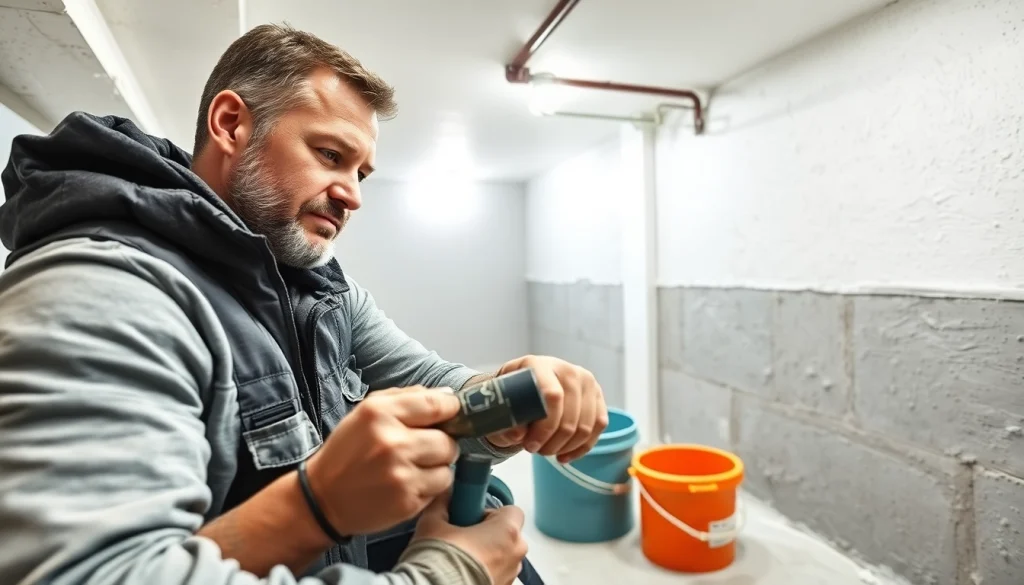Understanding the Importance of Basement Waterproofing
Why Basement Waterproofing Matters
Many homeowners underestimate the significance of proper basement waterproofing. Water can seep in through tiny cracks, leading to serious issues over time. By effectively waterproofing your basement, you are proactively protecting your home’s foundation and overall structure. This protective measure is especially crucial in regions where heavy rainfall or flooding is common, as it prevents excess moisture from accumulating, which can lead to mold growth, wood rot, and even structural damage.
Common Issues Caused by Water Damage
Water damage can manifest in numerous ways, and the consequences can be both immediate and long-lasting. Common issues include:
- Mold and Mildew: These thrive in damp environments, negatively impacting indoor air quality and presenting health risks to inhabitants.
- Structural Damage: Excess moisture can compromise the foundations, leading to cracks, bowing walls, and even foundation failure.
- Increased Repair Costs: Ignoring water issues can lead to more severe damage and, consequently, more expensive repairs over time.
- Pest Infestations: Damp spaces attract pests like termites, rodents, and insects, all of which can further damage your home.
Long-term Benefits of Waterproofing
Investing in basement waterproofing offers several long-term benefits:
- Enhanced Property Value: A dry basement can significantly increase a home’s marketability and property value.
- Improved Energy Efficiency: Proper insulation and protection against moisture helps maintain a consistent temperature and reduces energy bills.
- Peace of Mind: Knowing your home is protected against water damage leads to a greater sense of security and comfort.
Signs Your Basement Needs Waterproofing
Indicators of Moisture Problems
Identifying moisture problems early is crucial. Signs to look for include:
- Musty Odors: A persistent musty smell can be a strong indicator of mold growth or other moisture-related issues.
- Water Stains: Dark stains on walls or floors can signal current or past water intrusion.
- Condensation: Excess moisture can lead to condensation on walls and windows, particularly during hot and humid weather.
Visible Damage to Your Foundation
Many homeowners overlook damage to their basement walls and foundation. Cracks, flaking, and efflorescence (white powdery residue) are all signs that water might be penetrating the structure. Additionally, bowing walls and leaning structures can indicate serious foundation issues resulting from internal water pressure.
Preparing for a Waterproofing Assessment
If you suspect your basement has moisture issues, preparing for a waterproofing assessment can streamline the process. Here are key steps:
- Gather Documentation: Compile any previous repair records or assessments related to your home’s foundation.
- Clear the Basement: Remove items from the basement that may obstruct the assessment or hide signs of water damage.
- Document Visible Issues: Take photographs or notes on any visible damage, odors, or moisture issues.
Different Methods of Basement Waterproofing
Interior vs. Exterior Waterproofing
Understanding the differences between internal and external waterproofing methods is vital for an effective strategy. Interior waterproofing typically includes sump pumps, drainage systems, and sealants, which manage water ingress after it has entered. Conversely, exterior waterproofing focuses on preventing water from ever reaching your basement by installing barriers like membranes and proper grading around the foundation.
The Role of Drains and Sump Pumps
Drains and sump pumps play an essential role in basement waterproofing. Here’s how they function:
- Drains: Interior and exterior drains redirect water away from your foundation, significantly reducing the accumulation of moisture.
- Sump Pumps: These devices collect excess water and pump it away from the home, providing an active solution to combat flooding and water buildup.
Choosing the Right Waterproofing Solution
Choosing the right waterproofing solution depends on various factors including the age of your home, the level of water intrusion, and your budget. Consulting a basement waterproofing expert can help homeowners determine the best options tailored to their specific needs, ensuring optimal protection and performance.
DIY vs. Professional Basement Waterproofing
Benefits of Hiring Experts
While some homeowners may consider a DIY approach to basement waterproofing, hiring professionals comes with myriad advantages:
- Expert Assessment: Professionals can provide a comprehensive assessment and recommend solutions based on their expertise.
- Quality Assurance: Experts use high-grade materials and follow industry best practices, ensuring a durable solution.
- Warranty Protection: Hiring a professional often comes with warranties, providing added security and recourse should issues arise.
Risks of DIY Waterproofing Projects
Undertaking DIY waterproofing projects can be tempting but often comes with risks, including:
- Insufficient Solutions: Many DIY methods fail to address underlying issues, leading to recurring problems.
- Safety Hazards: Without the proper knowledge or equipment, DIY projects can lead to injuries or accidents.
- Increased Costs: What seems like a cost-saving measure can lead to higher expenses down the line if fixes are inadequate.
When to Call a Professional
Knowing when to involve professionals is crucial. Call for help when:
- You notice significant water pooling or persistent leaks.
- You identify extensive damage to your foundation or walls that seems beyond simple repair.
- You want to ensure a reliable and lasting waterproofing solution.
Maintaining Waterproofed Basements
Regular Inspections and Repairs
After a basement has been waterproofed, ongoing maintenance is essential. Regular inspections can catch early signs of potential issues, while prompt repairs can prevent complications from arising.
Best Practices for Basements Post-Waterproofing
To ensure the effectiveness of basement waterproofing, implement these best practices:
- Keep Gutters Clean: Regularly clean gutters to prevent overflow that can direct water toward the foundation.
- Maintain Proper Drainage: Ensure that landscaping slopes away from the foundation to direct water away from the base.
- Avoid Adding Heavy Landscaping: Large trees or water features close to the foundation can contribute to water issues.
Monitoring Humidity Levels
Monitoring humidity levels helps to ensure a dry atmosphere within the basement. Using dehumidifiers and humidity gauges can help manage moisture levels, thus maintaining a healthier environment and further protecting the structure.
